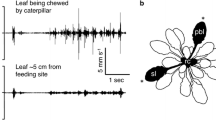Summary
An apparatus has been constructed for the detection of vibrations generated within plant tissue. This can detect vibrations due to water cavitation within fern sporangia. Using this detector ‘clicks’ have been obtained from Ricinus petioles and leaves in a condition when, from previous work, water cavitation might be expected.
Evidence is provided to show:
-
1.
That ‘click’ production is correlated with the water status of the plant tissue.
-
2.
There are reasons for opposing the possibility that ‘clicks’ result from tissue fracture alone.
-
3.
The ‘clicks’ may be detected in a wide range of plants.
The implications of the apparent vulnerability of water conducting systems in plants are discussed.
Similar content being viewed by others
Bibliography
Bode, H. R.: Beiträge zur Dynamik der Wasserbewegung in den Gefäßpflanzen. Jb. wiss. Bot. 62, 92–127 (1923).
Crafts, A. S.: Solute transport in plants. Science 90, 337–338 (1939).
Dixon, H. H.: Transpiration and the ascent of sap in plants, p. 102. New york: McMillan & Co. 1914.
Holle, H.: Untersuchungen über Welken, Vertrocknen und Wiederstraffwerden. Flora (Jena) 108, 73–126 (1915).
Milburn, J. A.: The conduction of sap. I. Water conduction and cavitation in water stressed leaves. Planta (Berl.) (prev. paper) 1966.
Pierce, G. J.: The state of water in ducts and tracheids. Amer. J. Bot. 4, 623–628 (1936).
Preston, R. D.: Theoretical and practical implications of the stresses in the water-conducting system in trees. In: Recent advances in botany. (Bot. Congr. Montreal 1959), vol. II, p. 1144–1149. Publ. 1961.
Scholander, P. F., H. T. Hammel, E. D. Bradstreet, and E. A. Hemmingsen: Sap pressure in vascular plants. Science 148, 339–345 (1965).
—, B. Ruud, and H. Leivestad: The rise of sap in a tropical liana. Plant Physiol. 32, 1–6 (1957).
Stocking, C. R.: Continuity, tensions and redistribution of water in plants. Ph. D. Diss. Univ. of California 1943.
—: The calculation of tensions in Cucurbita pepo. Amer. J. Bot. 32, 126–134 (1945).
Temperley, H. N. V.: The behaviour of water under hydrostatic tension. III. Proc. phys. Soc. 59, 199–207 (1947).
Weatherley, P. E.: The pathway of water movement across the root cortex and leaf mesophyll of transpiring plants. In: The water relation of plants, p. 85–100, Oxford: Blackwell Sci. Publ. 1963.
— The state and movement of water in the leaf. S.E.B. Symposia No. 19. The state and movement of water in living organisms, ed. Fogg, p. 157–184. Cambridge: Cambridge Univ. Press 1965.
Wylie, R. B.: Conduction in dicotyledon leaves. Iowa Acad. Sci. Proc. 53, 195–202 (1947).
Author information
Authors and Affiliations
Rights and permissions
About this article
Cite this article
Milburn, J.A., Johnson, R.P.C. The conduction of sap. Planta 69, 43–52 (1966). https://doi.org/10.1007/BF00380209
Received:
Issue Date:
DOI: https://doi.org/10.1007/BF00380209




